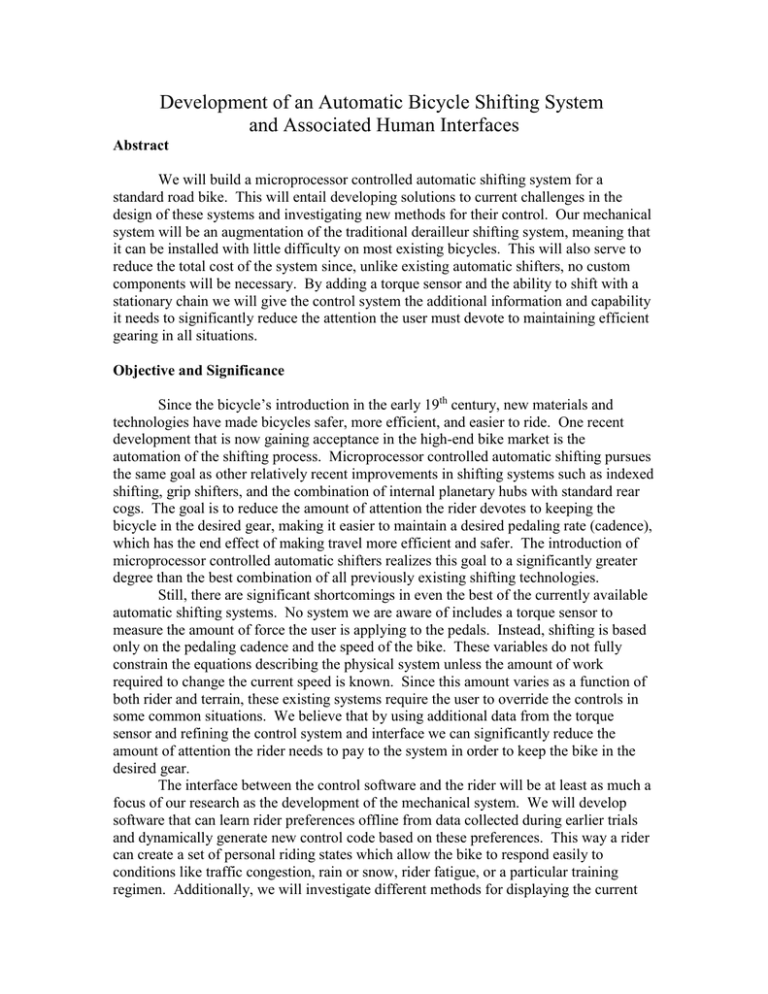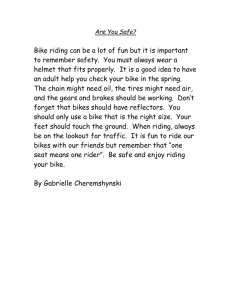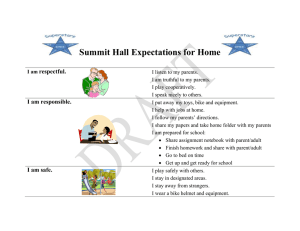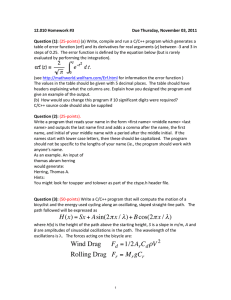Development of an Automatic Bicycle Shifting System and Associated Human Interfaces
advertisement

Development of an Automatic Bicycle Shifting System and Associated Human Interfaces Abstract We will build a microprocessor controlled automatic shifting system for a standard road bike. This will entail developing solutions to current challenges in the design of these systems and investigating new methods for their control. Our mechanical system will be an augmentation of the traditional derailleur shifting system, meaning that it can be installed with little difficulty on most existing bicycles. This will also serve to reduce the total cost of the system since, unlike existing automatic shifters, no custom components will be necessary. By adding a torque sensor and the ability to shift with a stationary chain we will give the control system the additional information and capability it needs to significantly reduce the attention the user must devote to maintaining efficient gearing in all situations. Objective and Significance Since the bicycle’s introduction in the early 19th century, new materials and technologies have made bicycles safer, more efficient, and easier to ride. One recent development that is now gaining acceptance in the high-end bike market is the automation of the shifting process. Microprocessor controlled automatic shifting pursues the same goal as other relatively recent improvements in shifting systems such as indexed shifting, grip shifters, and the combination of internal planetary hubs with standard rear cogs. The goal is to reduce the amount of attention the rider devotes to keeping the bicycle in the desired gear, making it easier to maintain a desired pedaling rate (cadence), which has the end effect of making travel more efficient and safer. The introduction of microprocessor controlled automatic shifters realizes this goal to a significantly greater degree than the best combination of all previously existing shifting technologies. Still, there are significant shortcomings in even the best of the currently available automatic shifting systems. No system we are aware of includes a torque sensor to measure the amount of force the user is applying to the pedals. Instead, shifting is based only on the pedaling cadence and the speed of the bike. These variables do not fully constrain the equations describing the physical system unless the amount of work required to change the current speed is known. Since this amount varies as a function of both rider and terrain, these existing systems require the user to override the controls in some common situations. We believe that by using additional data from the torque sensor and refining the control system and interface we can significantly reduce the amount of attention the rider needs to pay to the system in order to keep the bike in the desired gear. The interface between the control software and the rider will be at least as much a focus of our research as the development of the mechanical system. We will develop software that can learn rider preferences offline from data collected during earlier trials and dynamically generate new control code based on these preferences. This way a rider can create a set of personal riding states which allow the bike to respond easily to conditions like traffic congestion, rain or snow, rider fatigue, or a particular training regimen. Additionally, we will investigate different methods for displaying the current state of the controller to the user (LCD, motorized shifters, sounds), and evaluate a number of systems for acquiring user input. Because our mechanical design is based on the traditional two derailleur shifting scheme, it can be installed on an existing bike without replacing any components. Since the design is mechanically simple and makes use of readily available components the cost of upgrading an existing bike with our system should be significantly lower than that of upgrading with another commercially available system. Design There are four essential components of the mechanical design. We must construct all of them in order to carry out our user interface research and ensure that the system is at least as safe to ride as an unmodified bike. These four components are the control board, the while-pedaling shift system, sensors to measure variables which describe essential components of the bicycle’s state, and the power system. The control system will utilize an existing Botrics Cerebellum control board. The Cerebellum is well suited to this type of small mobile robotic control task. Additionally, we have previous experience programming and using the Cerebellum. The while-pedaling shift system allows the rider to change gears while moving the chain forwards by pedaling. It will consist of a pair of motors mounted on the downtube and attached at a very low gear ratio to the front and rear shift cables. Both motors will be equipped with encoders which indicate the location of each derailleur. By storing encoder offsets for each possible gear we can eliminate the need for the rider to trim the location of the front derailleur, a common problem with modern index shifters. The sensor package measures the speed of the bike, the cadence, and the amount of force the rider is applying to the pedals. Rotational encoders will record speed at the rear wheel and cadence. Torque will be derived from the current gear and the upper chain tension. That tension will be measured by a custom built tensiometer affixed to the rear fork. The tensiometer will measure the downwards force resulting from displacing the chain slightly upwards. Its horizontal motion will be compliant with motion of the chain caused by shifting. Power will be supplied by batteries which will be charged by a standard bicycle dynamo. In the event of low power or power loss the bike will maintain the last gear set. The system will then either disengage automatically or the rider will be able to disengage the system by moving a single lever on the downtube. The basic user interface will consist of a backlit LCD screen and a small number of levers and buttons for adjusting the state of the controller. The use of auditory and haptic interface elements will also be explored. For example, attaching servo motors to the existing shift levers so that they move as the user expects when the bike shifts gears might require less attention from the user than displaying that same information on an LCD screen. There are some nonessential components of the mechanical system which we may add if our interface testing indicates they would be useful. A while-stationary shift system would allow the bike to shift gears without the rider moving the chain forwards. This is useful when the user pedals in a high gear and then coasts to a stop without pedaling. Without a stationary shift system the user must begin pedaling again in their previous gear. Additional sensors to monitor rider position, or brake caliper tension may also be added if we determine that a need for them exists. Background Stuart Anderson has experience with bicycle mechanics and robotics. He has worked as a member of the Federation of Independent Robotic Explorers research group in the Carnegie Mellon Robotics Institute since 2001. Additionally he volunteers several hours each week repairing and building used bicycles. Kevin Oishi has experience with robotics as well as the specific technologies we plan to employ. He has worked in the Urban Search and Rescue group at the Robotics Institute for two years. In the course of this work he has gained experience working with the Cerebellum controller we plan to employ. Additionally his research has focused on the same issue of representing robot state information for human interfaces that we will face in developing the bike controller interface. Michael Blain has experience with electronics and robotics. He is minoring in robotics and has taken several courses in the field. He has practical experience in mechanical engineering and electronics as well. Presentation and Evaluation We will present the completed system as well as a paper describing our work at the 2004 Meeting of the Minds. Additionally we may choose to submit this paper to an appropriate academic conference. We will meet with our project advisors throughout the course of the project to evaluate our progress and final results. Dissemination The bike and all associated materials will be donated to the Carnegie Mellon Activities Board Green Bike program where it will be free for student use. Budget Used Bicycle Materials for Test Rig DC Motors Load Cell (Pressure Sensor) Cerebellum Control Board Dynamo Rechargeable Battery Pack LCD Screen Wheel/Cadence Rotation Encoders Tensiometer Materials Hardware and Assorted Materials (Bolts, Wires, Zip Ties, Housing, Drill Bits, Solder, etc) 50 30 3x120 90 80 40 3x20 35 20 50 50 Buttons and Levers Power Supply Electronics (Voltage Regulator and Trickle Charging) Total 30 20 915


